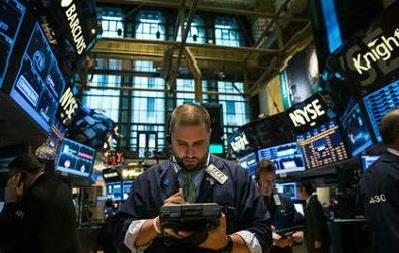June 12, 2013
NEW YORK: US stocks fell on Wednesday, with the Dow sliding more than 100 points on another volatile day as traders extended a selloff driven by concern about central banks winding down their stimulus measures.

US stocks followed overseas markets downward on Wednesday.
June 12, 2013
NEW YORK: US stocks fell on Wednesday, with the Dow sliding more than 100 points on another volatile day as traders extended a selloff driven by concern about central banks winding down their stimulus measures.

US stocks followed overseas markets downward on Wednesday.
The S&P 500 was caught between support near its 50-day moving average at 1,610.55 and resistance at its 14-day moving average at 1,637.27. The S&P 500 has closed below its 50-day moving average only once this year — in mid-April.
Traders have kept their focus on the possibility that the Federal Reserve will reduce its monthly bond purchases in coming months, removing one of the pillars of the US stock market's rally this year.
These worries have sparked volatility and triggered a pullback in US stock indexes from historic highs.
The Dow on Wednesday swung more than 200 points for the seventh time in the past 15 trading days, going back to Fed chairman Ben Bernanke's latest congressional testimony on May 22. At the time, he hinted that the Fed may begin to reduce its quantitative easing — consisting of $85 billion a month in bond purchases — in the coming months.
"There are concerns about the path for the Fed and the markets that benefited from QE and how those trades will unwind," said Paul Zemsky, head of asset allocation at ING Investment Management in New York.
"The level of uncertainty has gone up tremendously in the last month."
The CBOE Volatility Index, known as the VIX, shot up 8.9 per cent to 18.59. The VIX has jumped more than 20 per cent so far this week.
Zemsky said the perception of increased risk may be forcing large market players like hedge funds to sell, putting more downward pressure on stocks.
The Dow Jones industrial average sank 126.79 points or 0.84 per cent, to close at 14,995.23. The S&P 500 dropped 13.61 points or 0.84 per cent, to 1,612.52. The Nasdaq Composite dropped 36.52 points or 1.06 per cent, to end at 3,400.43.
The S&P 500 has fallen 3.4 per cent from its record closing high of 1,669.16 set on May 21.
On Wednesday, the benchmark index closed 2 points above its 50-day moving average of 1,610.55. If the S&P 500 falls below that level, the selloff could intensify.
American Express Co, down 2.4 per cent at $74.72, was the Dow's biggest per centage decliner.
In contrast, Hewlett-Packard was the biggest per centage gainer among the blue chips after its chief executive said revenue growth was "still possible" in fiscal 2014. The computer maker's stock jumped 2.8 per cent to $24.91.
Going against the sharp downturn was Cooper Tire & Rubber . The stock surged 41.1 per cent to $34.66 after India's Apollo Tyres agreed to buy the second-biggest US tire maker for about $2.5 billion.
Shares of Booz Allen Hamilton fell 3.5 per cent to $16.54 after Susquehanna Financial Group's analysts said US intelligence agencies probably will freeze some of the company's projects temporarily, pending a review of how it handles classified information.
Booz Allen said on Sunday that one of its employees was responsible for leaking details of a top secret US surveillance program.
About 6.2 billion shares exchanged hands on the New York Stock Exchange, the Nasdaq and NYSE MKT, below the daily average so far this year of nearly 6.38 billion.
Decliners outpaced advancers by a ratio of more than 4 to 1 on the NYSE. On the Nasdaq, more than two stocks fell for every one that rose.
Courtesy: Reuters
















































































































